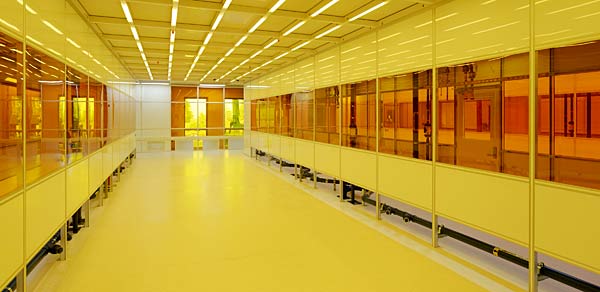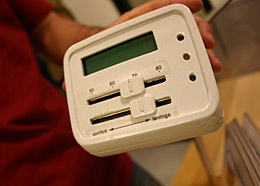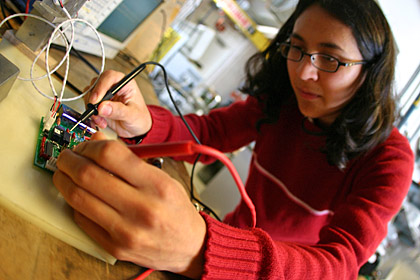Dedication of new CITRIS headquarters marks new stage of innovation to help fuel economic growth
 This 15,000-square-foot cleanroom, one of two in the Marvell Nanofabrication Laboratory, will allow researchers in the new Sutardja Dai Hall to to engineer computer chips to extremely fine tolerances (Photo ©2008 Tim Griffith; all rights reserved)
This 15,000-square-foot cleanroom, one of two in the Marvell Nanofabrication Laboratory, will allow researchers in the new Sutardja Dai Hall to to engineer computer chips to extremely fine tolerances (Photo ©2008 Tim Griffith; all rights reserved)| 27 February 2009
Source: http://berkeley.edu/news/media/releases/2009/02/27_citris.shtml

Sutardja Dai Hall
Facts at a Glance
LOCATION
Northeast corner of campus, between Cory Hall and the Naval Architecture Building
SIZE
7 stories (5 above ground, 2 basement levels)
141,000 gross square feet
DESIGN FEATURES
Exterior
Textured board form with light metal lines to complement look of neighboring campus buildings
Interior
- Marvell Nanofabrication Laboratory with two 15,000 square-foot cleanrooms (Class 100, Class 1,000)
- Levels 4 through 7 are research floors mixed with collaborative spaces to promote interaction
- Office and conference rooms
- Distance learning classrooms
- Tech Museum on main floor
- 1 auditorium (149 seats)
- Cybercafe
OCCUPANTS
50 CITRIS faculty affiliates and hundreds of students
Administrative staff for CITRIS
PROJECT TEAM
UC Berkeley Capital Projects
SmithGroup
Hathaway Dinwiddie Construction
BERKELEY — The newest research facility on the campus of the University of California, Berkeley, to be dedicated today (Friday, Feb. 27), embodies the innovation and entrepreneurship needed to fuel economic growth and arrives at a time when the state and nation seek relief from the recession.
At a ceremony this afternoon, Sutardja Dai Hall will become the new home of the Center for Information Technology Research in the Interest of Society (CITRIS) and the Banatao Institute@CITRIS Berkeley. CITRIS is a multi-disciplinary program that combines the skills and talents of more than 300 faculty researchers and thousands of students from four UC campuses - Berkeley, Davis, Merced and Santa Cruz - with industrial partners from more than 60 corporations.
CITRIS is one of four Governor Gray Davis Institutes for Science and Innovation - renamed last year to recognize the former governor's role in their creation. The state established the institutes in 2001 in collaboration with the University of California and leading-edge businesses as an investment in the state's economic future, and to maintain California's reputation for fostering groundbreaking discoveries.
"Today is a milestone for CITRIS, one that will help it fulfill its mission of creating useful technologies that aid our society and strengthen our economy," said Gov. Arnold Schwarzenegger in a statement to be read at the event. "The work being done here will give us greater tools to tackle our health care, energy and environmental challenges and I applaud the many researchers and students who will advance this work within the walls of this beautiful new building."
As the headquarters for CITRIS, the 141,000-square-foot building will be open to researchers from the four UC campuses in wide-ranging disciplines, including engineering, energy, health, law, public policy, political science and new media. The space includes state-of-the-art research laboratories, distance learning classrooms, offices, a 149-seat auditorium, conference rooms, a technology museum and a cybercafé.
The new building replaces Davis Hall North in the northeast corner of the UC Berkeley campus and consists of five above-ground and two basement floors.
"In this research institute, UC faculty and students are working with colleagues from the private sector to think about information technology in new ways, and to apply information technology solutions to some of the most pressing problems facing our society," said UC President Mark G. Yudof. "The innovations being developed here will help produce new waves of economic growth for California - in clean energy, in health care, in smart infrastructure. It is exactly what we need to be doing in challenging economic times such as these."
Sutardja Dai Hall will house the Marvell Nanofabrication Laboratory, equipped in two 15,000 square-foot cleanrooms with some of the world's most advanced semiconductor fabrication equipment. Electronic microchips can be produced in the laboratory at resolutions 100,000 times smaller than the diameter of a human hair. Seven tons of steel reinforcement and 8,000 cubic yards of concrete were used to construct the nanofabrication lab, which boasts support floor slabs that are 39 inches thick, allowing for structural vibrations of less than 125 micro-inches per second.
It will be the second building on the UC Berkeley campus connected to what was originally called the California Institutes for Science and Innovation. In 2007, the campus dedicated Stanley Hall, a cutting-edge biophysical science research facility hosting researchers from the California Institute for Quantitative Biosciences (QB3).
"At UC Berkeley, and throughout the University of California, we take seriously our responsibility for shaping society's economic and social well being," said UC Berkeley Chancellor Robert J. Birgeneau. "You need only look to the full name of CITRIS — the Center for Information Technology Research in the Interest of Society — to appreciate that. That mission is part of the very DNA of this university."
"CITRIS shortens the pipeline between world-class laboratory research in science and engineering and the creation of startups, companies and whole industries," said CITRIS Director Paul Wright, UC Berkeley professor of mechanical engineering. To facilitate the development of new ideas and companies, CITRIS-developed technologies will be made available through a royalty-free license, he added.
The many innovative projects to be developed in the new building include:
 An early prototype of a demand response thermostat being developed by researchers at CITRIS. Users decide whether to program the thermostat to maximize energy and cost savings. When set to maximize savings, the thermostat automatically reduces power consumption during times of peak energy demand. (Aaron Walburg/CITRIS photo)
An early prototype of a demand response thermostat being developed by researchers at CITRIS. Users decide whether to program the thermostat to maximize energy and cost savings. When set to maximize savings, the thermostat automatically reduces power consumption during times of peak energy demand. (Aaron Walburg/CITRIS photo)- Demand Response, a project that develops thermostats that users can program to automatically lower power consumption during times of peak energy demand. Such energy-saving devices could eliminate the need to build five power plants, which, in turn, could reduce carbon dioxide emissions by 9 million tons a year and save Californians $10 billion, the researchers said.
- Mobile Millennium, a project that uses GPS-enabled cell phones to help monitor congestion on side roads as well as on major highways. If 3,000 users shave even 30 hours a year from their commute time, the project will have prevented the waste of more than 70,000 gallons of fuel, according to the researchers.
- CellScope, a project that turns a conventional cell phone into a compact, high-resolution, handheld microscope with the capability to capture, organize and wirelessly transmit images for analysis. This greatly expands the access to healthcare services from nearly any location in the world, including small and frontier clinics where health care providers are battling malaria, tuberculosis and sickle cell disease.
- Climate Navigator, an online forum for technology innovators, researchers, policy makers and business leaders to create new models and guidelines for addressing climate change over the coming decade and beyond.
 UC Berkeley graduate student Ilse Ruiz-Mercado tests the circuitry she designed for a small, inexpensive sonic anemometer as part of the CITRIS Intelligent Infrastructure program. The device was developed to measure air flow rates in rural homes to improve modeling of pollutants from indoor cooking fires. (Aaron Walburg/CITRIS photo)
UC Berkeley graduate student Ilse Ruiz-Mercado tests the circuitry she designed for a small, inexpensive sonic anemometer as part of the CITRIS Intelligent Infrastructure program. The device was developed to measure air flow rates in rural homes to improve modeling of pollutants from indoor cooking fires. (Aaron Walburg/CITRIS photo)The CITRIS building is made possible through a combination of public and private funds. It is named in recognition of brothers Sehat and Pantas Sutardja, and of Weili Dai, the three co-founders of Marvell Technology Group, an international semiconductor company based in Santa Clara. All three are UC Berkeley alumni: The brothers hold Ph.D. degrees in electrical engineering and computer sciences, and Dai, who is married to Sehat Sutardja, has a B.S. degree in computer science.
The Banatao Institute@CITRIS Berkeley takes its name from Dado Banatao, founder of Tallwood Venture Capital and chair of the UC Berkeley College of Engineering Advisory Board, and his wife, Maria, trustee of the UC Berkeley Foundation.
The construction of Sutardja Dai Hall was managed by UC Berkeley Capital Projects. The building was designed by the architectural and engineering firm SmithGroup, and built by the general contracting firm Hathaway Dinwiddie Construction, both based in San Francisco.
"The birth of Sutardja Dai Hall signals a new stage of maturity and productivity for CITRIS," said Wright. "The profound challenges we now face in California and the world are really tremendous opportunities for progress, ones that we stand ready to explore."
